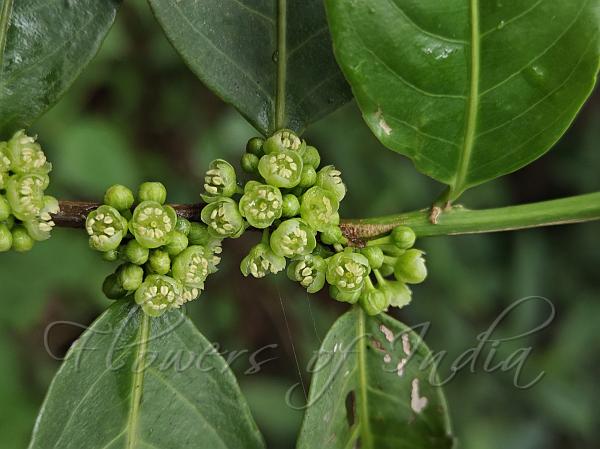|
| Saptrangi |
|

|

| File size | 588451 |
| Original date | 6/12/25 12:06 PM |
| Resolution | 2048 x 1536 |
| Flash | Flash did not fire, auto |
| Focal length | 5.59mm |
| Exposure time | 1/53s |
| Aperture | 1.8 |
| Focus Distance | |
| Metering Mode | Center weighted average |
| Camera make | OnePlus |
| Camera model | OnePlus 12R |
| Sensor type | MonochromeArea |
|
|
|
|
Photo: |
Botanical name: Casearia zeylanica Family: Salicaceae (Willow family)
Synonyms: Casearia esculenta, Casearia varians, Vareca zeylanica
Synonyms: Casearia esculenta, Casearia varians, Vareca zeylanica
Saptrangi is a small understorey evergreen tree, up to
15 m tall. Bark is greenish, smooth; blaze light orange. Branchlets are
round, hairless. Leaves are simple, alternate, distichous; stipule
falling off; leaf-stalk 0.4-0.9 cm long, channeled, hairless; blade
5-15 x 2.5-6.4 cm, narrow elliptic to elliptic-ovate, tip tapering,
acumen usually twisted, base narrowed or subpointed, margin entire or
sawtoothed, papery, hairless, with pellucid transparent dots and lines.
Midrib is flat above; secondary nerves 6-10 pairs; tertiary nerves
broadly netveined. Flowers are borne in fascicles in leaf-axils,
hairless, greenish, petals absent. Capsules are 2-3 valved, almost spherical to
ellipsoid, yellow-orange when ripe; seeds many with arils. Saptrangi is found
in Indian Subcontinent to Myanmar, including Western Ghats.
Flowering: May-June.
Medicinal uses: Saptrangi is used to treat a
range of ailments, including anticancer properties, dyspepsia,
influenza, malaria, respiratory infections, and as an antidote for
insect stings. The roots are known for their purgative, anthelmintic,
carminative, rubefacient, and anodyne properties, and are used for
abdominal pain, constipation, and skin issues. Additionally, the leaves
are traditionally used to relieve asthma, and the seeds are utilized
for treating snakebites.
Saptrangi is used to treat a
range of ailments, including anticancer properties, dyspepsia,
influenza, malaria, respiratory infections, and as an antidote for
insect stings. The roots are known for their purgative, anthelmintic,
carminative, rubefacient, and anodyne properties, and are used for
abdominal pain, constipation, and skin issues. Additionally, the leaves
are traditionally used to relieve asthma, and the seeds are utilized
for treating snakebites.
Medicinal uses:
 Saptrangi is used to treat a
range of ailments, including anticancer properties, dyspepsia,
influenza, malaria, respiratory infections, and as an antidote for
insect stings. The roots are known for their purgative, anthelmintic,
carminative, rubefacient, and anodyne properties, and are used for
abdominal pain, constipation, and skin issues. Additionally, the leaves
are traditionally used to relieve asthma, and the seeds are utilized
for treating snakebites.
Saptrangi is used to treat a
range of ailments, including anticancer properties, dyspepsia,
influenza, malaria, respiratory infections, and as an antidote for
insect stings. The roots are known for their purgative, anthelmintic,
carminative, rubefacient, and anodyne properties, and are used for
abdominal pain, constipation, and skin issues. Additionally, the leaves
are traditionally used to relieve asthma, and the seeds are utilized
for treating snakebites. | Identification credit: Jatin Vaity | Photographed in Matheran, Maharashtra. |
• Is this flower misidentified? If yes,